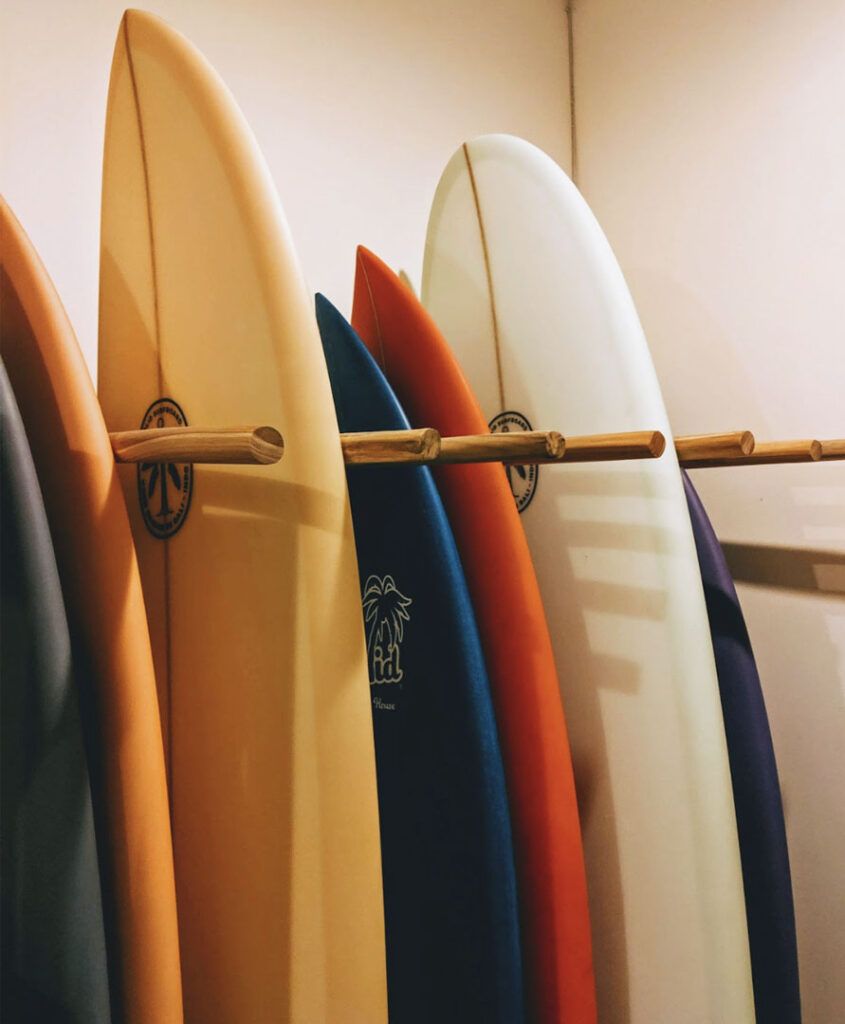SURF BOARDS
SOLID SURF & YOGA HOUSE
The Ultimate Guide to Surf Boards :
Everything You Need to Know
Understanding the Anatomy of a Surf Board
If you’re new to surfing, choosing the right surfboard can seem daunting. With so many sizes, shapes, and materials to consider, it’s easy to get overwhelmed. However, understanding the basics of surfboard anatomy can help you make an informed decision.
The most important components of a surfboard are the deck, bottom, rails, nose, and tail. The deck is the top of the board where you stand, while the bottom is the underside that contacts the water. The rails are the edges of the board, and their shape affects the board’s maneuverability. The nose is the front of the board, and the tail is the back.
There are several types of surfboards, each designed for different conditions and skill levels. Longboards, for example, are typically 8 to 12 feet long and are great for beginners because they’re stable and easy to paddle. Shortboards, on the other hand, are between 5’6″ and 7 feet long and are designed for more advanced surfers who want more maneuverability.
Fish boards are shorter and wider than shortboards, making them ideal for smaller waves. They’re also great for intermediate surfers who want to improve their speed and maneuverability. Gun boards are long and narrow, designed for big waves and experienced surfers.

Materials Used in Surf Board Construction
The three most common materials used in surfboard construction are polyurethane foam, polystyrene foam, and balsa wood. Polyurethane foam is the most popular material and is used to make most traditional surfboards. Polystyrene foam is lighter and stronger than polyurethane foam, making it a popular choice for high-performance boards.
Balsa wood, on the other hand, is a natural material that’s been used in surfboard construction for decades. While it’s not as common as foam, it’s still used to make some high-end boards because of its durability and unique flex.
Choosing the Right Size
Choosing the right size surfboard is crucial to your success as a surfer. If your board is too small, you’ll struggle to catch waves and maintain balance. If it’s too big, you’ll have a hard time maneuvering.
Your weight and skill level are the two most important factors to consider when choosing a surfboard size. As a general rule, the longer and wider the board, the more stable it will be. If you’re a beginner, start with a longboard that’s at least 8 feet long.
Maintaining Your Surf Board
Proper maintenance is key to keeping your surfboard in good condition. Rinse your board with fresh water after each use to remove sand and salt. Store it in a cool, dry place out of direct sunlight, and avoid exposing it to extreme temperatures.
If your board gets dinged or damaged, it’s important to repair it right away. Small dings can be filled with surfboard resin, while larger dings may require professional repair.

Customizing Your Surf Board
Many surf board manufacturers offer customization options to help you create a board that is uniquely tailored to your preferences and skill level. Here are a few ways you can customize your surfboard:
The size of your board is a crucial factor in your surfing experience. The general rule is that bigger boards are easier to ride, while smaller ones offer more maneuverability. You can work with your board manufacturer to determine the best size for your height, weight, and skill level.
The shape of your surfboard determines how it performs in the water. For example, a board with a rounder nose and fuller rails is better suited for small, mushy waves, while a board with a pointed nose and thinner rails is designed for larger, more powerful waves. You can work with your board manufacturer to choose a shape that matches the types of waves you plan to surf.
The rocker refers to the curve of the board from nose to tail. A board with more rocker is easier to turn, while a board with less rocker is faster and more stable. You can work with your board manufacturer to choose a rocker that matches your skill level and surfing style.
The fins on your surfboard play a crucial role in its stability and maneuverability. Most boards come with a standard three-fin setup, but you can customize the size, shape, and placement of the fins to achieve different levels of speed, control, and stability.
Finally, you can also customize the graphics on your board to add a personal touch. Many board manufacturers offer a range of designs and color options, or you can work with an artist to create a custom design that reflects your personality and style.
Caring for Your Surf Board
Proper surfboard maintenance is essential for prolonging the life of your board and ensuring that it performs at its best. Here are a few tips for caring for your surfboard:
Rinse your board with fresh water after each use to remove salt and sand.
Store your board in a cool, dry place out of direct sunlight.
Avoid exposing your board to extreme temperatures, as this can cause the foam to delaminate or warp.
Repair any dings or cracks in your board as soon as possible to prevent water from seeping in and causing further damage.
Avoid putting pressure on the board when it’s out of the water, such as leaning it against a hard surface or stacking other boards on top of it.
By taking good care of your surfboard, you can ensure that it lasts for many years and provides you with many unforgettable surfing experiences.
Conclusion
Choosing the right surfboard is crucial for any surfer, whether they are a beginner or an experienced rider. It is important to consider various factors such as the size, shape, and material of the board before making a purchase. Additionally, knowing how to properly care for and maintain a surfboard can prolong its lifespan and ensure optimal performance. With the information provided in this article, we hope you can make an informed decision when it comes to selecting and customizing your surfboard. Remember to always prioritize safety and enjoy the waves responsibly.
Frequently Asked Questions (FAQ)
About Surf Boards
- The ideal size of a surfboard for a beginner is usually around 8 to 9 feet long, with a width of around 22 to 24 inches, and a thickness of around 2.5 to 3 inches. This size provides stability and buoyancy, making it easier for beginners to catch waves and maintain balance.
A longboard is a surfboard that is typically longer than 9 feet, and is designed for stability and ease of use. A shortboard, on the other hand, is usually less than 7 feet long, and is designed for speed and maneuverability. Shortboards are typically more challenging to ride than longboards.
- A soft-top surfboard is a surfboard that has a foam deck, making it softer and more forgiving than traditional fiberglass surfboards. They are often used by beginners and surf schools, as they are less likely to cause injury and can withstand more wear and tear.
The best material for a surfboard depends on personal preference and skill level. Fiberglass boards are the most common and provide great performance, but are fragile and can be costly to repair. Foam boards are more durable and affordable, but offer less performance. Epoxy boards offer a good compromise between durability and performance.
It is not recommended to surf with a broken surfboard, as it can be dangerous and cause further damage to the board or yourself. It’s best to get any damage repaired before taking the board out again.
The frequency of waxing your surfboard depends on how often you surf and the water temperature. In general, it’s recommended to wax your board before every surf session, or every other session if the water is cold.
- The right fin for your surfboard depends on the type of waves you’ll be surfing and your personal preference. Larger fins provide more stability and are good for bigger waves, while smaller fins provide more maneuverability and are good for smaller waves.
Yes, most airlines allow surfboards to be checked as luggage, although there may be size and weight restrictions. It’s best to check with the airline beforehand and pack the board securely.
Proper maintenance of your surfboard includes regularly cleaning it with fresh water after each use, drying it thoroughly before storing it, and keeping it out of direct sunlight and extreme temperatures. It’s also important to get any dings or damage repaired as soon as possible.
A surfboard leash can be used on most types of surfboards, although it’s important to make sure the leash is the appropriate length for the board and that the attachment point is secure. Some surfers prefer not to use a leash on certain types of boards, such as longboards.


